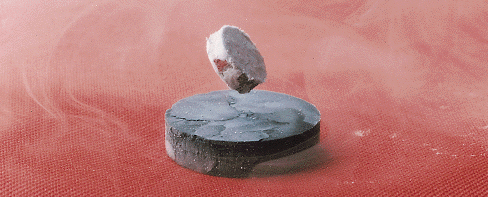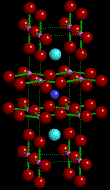 "What is Physics Good For?"
"What is Physics Good For?"
Extra credit is available at the end of this page. Please respond before 9 AM, Monday, October 16th, 2000.

Superconductors
 So far in 251, we have talked about electric charges and fields, and we have talked about conductors, real and ideal.
So far in 251, we have talked about electric charges and fields, and we have talked about conductors, real and ideal.
We started with "ideal" conductors, we defined these as materials
in which charge is completely free to move, and in which there are arbitrarily
large amounts of positive and negative charge available (charge is infinitely
divisible). From these requirements, we dervived a few useful facts - Any
excess charge on a conductor must reside on its surfaces, no electric fields
can exist within the conducting medium, and any conducting object must be
at a single electric potential.
Next, we moved on to real conductors, we talked about the microscopic model
of conduction in terms of free charges scattering within the conductor,
and we characterized the material by its resistivity. We also discussed
circuits, in which both real conductors (resistors) and ideal conductors
(wires and capacitor plates) played a role.
Are these "ideal" conductors a useful concept without any physical
analog, or do they really exist? To quote a popular commercial, "Not exactly." There are no materials which are simply perfect electrical conductors and have no other properties to speak of. However, there are materials which conduct electric current with zero resistance: superconductors.
superconductivity is one of the strangest and most exciting discoveries of the twentieth century. Even though physicists had used the idea of perfect conductors for many years, they never really imagined that such a material would be found. However, in 1911, a Dutch physicist named Heike Kammerlingh Onnes discovered that mercury (Hg) lost any trace of resistivity if cooled to the temperature of liquid helium. Two years later, he won a Nobel prize for his discovery.
In the years since Onnes discovery, 25 other chemical elements were found to become superconductors at very low temperatures. The temperature at which a material becomes a superconductor is usually called Tc, which stands for "critical temperature." the highest critical temperature among the chemical elements is 9.5 K (for niobium, Nb). the lowest is 0.012 K (for tungsten, W). Until recently, the highest critical temperatures were to be found in niobium alloys such as NiTi (niobium titanium) and NbSn3 (niobium tin).
The image at the right is the crystal structure of the first material known
to be a superconductor at the temperature of liquid nitrogen (77 K),YBa2Cu3O7. This is quite cold, but it is far warmer than the previous record, only 23 K. Furthermore, liquid nitrogen is fairly cheap and readily available in most places. This makes it a far more attractive coolant than liquid helium, which is far more expensive and is totally unavailable in many parts of the world.
 When we describe the resistance of a superconductor as zero, do we really
just mean very small? No! According to the theory of superconductivity if
a current is induced in a superconducting ring, the lifetime of that current
is predicted to be ten to the ten to the ten years. This is to large a number
to verify directly, but the best experiments thus far establish a lower
bound of 105 years.
When we describe the resistance of a superconductor as zero, do we really
just mean very small? No! According to the theory of superconductivity if
a current is induced in a superconducting ring, the lifetime of that current
is predicted to be ten to the ten to the ten years. This is to large a number
to verify directly, but the best experiments thus far establish a lower
bound of 105 years.
For many years after Onnes discovery superconductivity was known to exist
only near absolute zero, and only in a few pure elements. Later, superconductivity
was discovered in several compounds and alloys. In some cases, these materials
were found to superconduct at higher temperature than any of the known pure
elements. In fact, for many years the "record" was held by an
alloy Nb3Ge which becomes superconducting at about 23.2 K.
In recent years, interest in superconductivity has blossomed with the discovery
superconductivity at far higher temperatures. Two broad categories exist.
Superconductivity was discovered in ceramic materials in 1986 by A. Muller
and G. Bednorz, two scientists working at the IBM research lab in Zurich,
Switzerland. Their samples showed signs of superconductivity at 35 K. Within
a year, scientists all over the world were working to find new ceramic superconducting
compounds. This activity culminated in the "Woodstock of Physics"
an all night session at an American Physical Society meeting in March of
1987. At that meeting, several researchers showed data indicating that they
had purified samples of YBa2Cu3O7that
showed superconductivity at about 93 K. Soon thereafter, Bednorz and Muller
were also awarded the Nobel Prize.
Since 1987, physicists have discovered ceramic compounds that superconduct
at even higher temperatures. In addition, they have found superconductivity
in compounds based on
"buckyballs" spherical carbon molecules whose shape is quite similar to that of a soccer ball.
In addition to their electronic properties, superconductors also have magnetic properties (see the picture at the top of this page!). In terms of the terminology in your text, superconductors are diamagnetic. That is, they have a negative susceptibility, and acquire a polarization opposite to an applied magnetic field. This is the reason that superconducting materials and magnets repel one another. Of course, unlike other diamagnets (such as copper) superconductors have a very LARGE negative susceptibility, so the repulsive force is LARGE as well.
 Superconductivity is exciting both because it is strange and because it
has the potential to improve our lives. Of the many possible applications
of superconductivity, the grandest is that suggested by the image of the floating magnet that began this essay
- the magnetically levitated (MAGLEV) train. I will not attempt to list
the many other possible applications, rather, I leave that as an exercise
to the interested reader.
Superconductivity is exciting both because it is strange and because it
has the potential to improve our lives. Of the many possible applications
of superconductivity, the grandest is that suggested by the image of the floating magnet that began this essay
- the magnetically levitated (MAGLEV) train. I will not attempt to list
the many other possible applications, rather, I leave that as an exercise
to the interested reader.
You can get a lot more information about this subject on the internet. Here are a few search engines
1. Alta Vista
2. Google
3. Northern Light
4. Ask Jeeves
5. Infoseek
And here are a few good links to get you started.
1.

 2.
2.

 3.
3.

 4.
4.


Research Questions (1 point extra credit each!)
- List three widely different applications of superconducting material
(at least one that is already being used).
- What is the highest known value of Tc?
- The most successful theory describing superconductivity is called
the BCS theory, why?
- How many people have been awarded the Nobel prize for work involving
superconductivity?
This site is made possible by funding from the National Science Foundation (DUE-9981111).
©2001 A. Gavrin and G. Novak, all rights reserved.
|



 "What is Physics Good For?"
"What is Physics Good For?"


 When we describe the resistance of a superconductor as zero, do we really
just mean very small? No! According to the theory of superconductivity if
a current is induced in a superconducting ring, the lifetime of that current
is predicted to be ten to the ten to the ten years. This is to large a number
to verify directly, but the best experiments thus far establish a lower
bound of 105 years.
When we describe the resistance of a superconductor as zero, do we really
just mean very small? No! According to the theory of superconductivity if
a current is induced in a superconducting ring, the lifetime of that current
is predicted to be ten to the ten to the ten years. This is to large a number
to verify directly, but the best experiments thus far establish a lower
bound of 105 years.